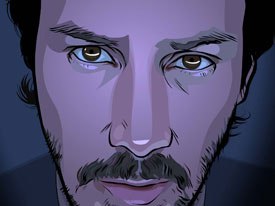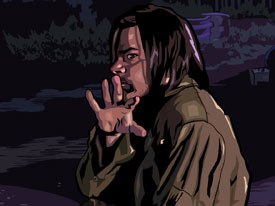Marisa Materna chats with director Richard Linklater on the production of A Scanner Darkly, which utilizes interpolated rotoscoping to bring live-action footage into an animated dream world.

A Scanner Darkly brings Richard Linklater back to interpolated rotoscoping, the same animation technology he used in Waking Life. It took 500 hours to get a minute on screen. All images © 2005 Warner Bros. Ent.
Truth or fiction? Are we being watched? Who is in control? Are my friends really my friends? Is this an illusion?
These are just some of themes in the Philip K. Dick adaptation A Scanner Darkly hitting theaters on July 7, 2006. Starring Keanu Reeves, Winona Ryder, Robert Downey Jr., Woody Harrelson and Rory Cochrane, this film, inspired by Dicks real life drug addiction and his experiences, is a dark and caustic journey into the lives of five friends who have been seduced by a drug referred to as Substance D or Death.
A Scanner Darkly was written and directed by Richard Linklater who is taking a departure from recent mainstream films such as School of Rock and Bad News Bears back to a more surreal project using the same animation technology he used in his 2001 film Waking Life, called interpolated rotoscoping developed by fellow Austenite and pal, Bob Sabiston.

The technology enhances the viewers experience of the film and becomes part of the storytelling process. A Scanner Darkly has streams of paranoia, conspiracy and despair, all which are intensified by the rotoscoped animation.
The technology really triggered something in me when I first saw the software at work. And I thought it would work well for this type of film. But making this movie was a lot of work, I think we spent more than 500 hours just for one minute of animation, says Linklater.
As in Waking Life, this technology enhances not only the viewers experience of the film, but becomes part of the storytelling process. A student of philosophy, Linklater seems to enjoy delving into surreal and alternative universes. A Scanner Darkly has streams of paranoia, conspiracy and despair, all which are intensified by the rotoscoped animation.
Linklater offers, Philip Dick is always asking What is reality? and creating situations that seem like the real world, but really arent. So the technique is very effective. Ryder added, For me, it created a real emotional effect. Producer Tommy Pallotta admits that they conceptualized this from the beginning. The animation gives the audience a buzz and they will feel unsettled. The characters are going through drug use, brain disintegration and it transports you to another universe.
The animation also was instrumental in presenting the film as a graphic novel. In Waking Life, wildly different styles and colors were used specifically for the different scenes which represented the varied philosophical themes in that film, while in A Scanner Darkly, using a consistent color palette and visual composition, the film successfully creates that continuity of a graphic novel. Which seems fit for a film that, although set in the future with neo-technological elements, it is not a sci-fi film, but more character-based.

The animation also was instrumental in presenting the film as a graphic novel. This film uses a consistent color palette and visual composition and successfully creates the continuity of a graphic novel.
The story is about Bob Arctor (Reeves), who is leading a double life as a drug addicted former suburbanite and as an Orange County sheriff named Fred working undercover and assigned to observe himself and the goings-ons of his slacker druggie roommates Jim Barris and Ernie Luckman (enthusiastically portrayed by Downey Jr. and Harrelson, respectively). Cochrane plays Freck the most extreme junkie of the group and Ryder is Arctors girlfriend Donna Hawthorne. It takes place not far in our future in the year 2013 (however, very far in the future for Dicks original book published in 1977) in suburban Orange County when the U.S. has lost the war on drugs and the use of Substance D has taken over.
Part character drama, part psychological think-piece, this film reeks of paranoia, suspicion of the government and authority and wild with conspiracy theories eerily reflective of current societal topics. Reeves described it as a commentary film with cautionary aspects to it. Ryder agrees, To me its really eerie how relevant it is politically and socially. I thought Dick was really, really on the money when he wrote it; its amazing what he predicted. And to me... I just think its a terrifying time right now in this country and in the world.
In a recent Los Angeles Times feature (7/2/06) about Linklater, the reporter reflected on the fact that as the director of two politically charged films this year, including the much-awaited Fast Food Nation releasing this fall, he finds himself frequently talking about the intersection of life, art and politics. All of which seems to suit Linklater just fine. Wilmer Valderama, who stars in the upcoming Fast Food Nation, notes that Linklater, is the director of this generation He really allows himself to bend the rules of moviemaking. His endings arent necessarily happy endings.

The scramble suit (left) is a moving mosaic of various images of people that changes every four frames. The actors wore simple gray sweat suits in the live-action filming and a team of illustrators drew the revolving images.
One of the major story elements includes the use of a scramble suit that Fred wears while at work in the sheriffs office that hides his identity. The suit is a moving mosaic of various images of people that changes every four frames. The suit was described in the book as a vague blur. Eventually, throughout the film more than 1,000 people appear in the scramble suit, even Philip Dick, himself. The actors wore simple gray sweat suits in the live-action filming. And then a team of illustrators was used to draw the revolving images.
We just let them go for it and draw like crazy. Although at times they needed to be reined in so there werent too many recognizable faces, because we thought it might detract from the film, said Pallotta. But the result is effective and the suit itself becomes another character in the movie.
Pallotta says this movie was a challenge to produce having to make basically two separate films one live-action and one rotoscoped. But offers that he felt the animation element was crucial to this particular film and probably wouldnt have gotten made otherwise. In some ways it was easier, knowing that if a boom got into the shot, it could be animated out later, he says. They were also able to spend less money on the live-action shoot, such as with set decorations, because they knew they would be able to enhance the look later in the animation process.
The actors as well found they kept the knowledge that they were going to be animated over later in their minds. I didnt have my face to convey information so I might move a little bigger especially when I was in the scramble suit, says Reeves. Cochrane too says he tried to do more with his facial gestures and took some liberties that he normally wouldnt have done. The artists did visit the set on occasion and would request certain elements that they would need in the compositing stage.
The drawing is done directly on computer. The artists can go back and forth, one frame at a time and the computer recalls every brushstroke. The outline drawn is then filled with color a frozen layer can also be created in the background that doesnt move. The layers can be separated and edited as needed. We worked more with illustrators, not necessarily trained animators, because we wanted this film to have a singular visual style, says Pallotta.

Drawing for this film was done directly on computer. The artists went back and forth, one frame at a time and the computer recalled every brushstroke. The outline was then filled with color.
Dicks other books and stories that have been adapted into film include Blade Runner, Minority Report, Total Recall and Paycheck. However, Reeves and Linklater both feel that this is the most specifically adapted film. Even Dicks two daughters were very involved in the making of this film, visiting the set often. They were never so involved with any of the film projects of any of their fathers writings that were brought to film, and it was great, Linklater said in an interview. They knew it was a very personal story for him and I wanted to stay faithful to the book and wanted to tell the whole story.
A fan of Dick, Reeves agrees, This is the first true adaptation of a Philip K. Dick film, and speaking as Philip K. Dick fan. I feel this is the best one.
Harrelson and Downey Jr. both agree from the onset, the script was strange, It is a bizarre kind of story; its stories within stories, strange realities within strange realities. You dont know whats real and whats illusion, says Harrelson. Ryder, who knew Dick indirectly as a friend of her godfather Timothy Leary and her father ran in the same social circles as Dick, says, The script, which really captured the feeling of the book, is almost impossible to describe. To me, its ultimately about identity loss of identity, search for identity, adds Ryder.

For director Richard Linklater, Philip Dicks work always asks, what is reality? while creating surreal situations. This makes the interpolated rotoscoping technique very effective.
Certainly, this film does not glorify drug use, as funny as the characters and situations can be (Cochrane, in particular, has some hilarious moments of hallucination). The film stays true to the essence of the dark comedic elements of the book, but with the thru-line that the truth behind these characters is really quite tragic. But Dicks daughters were prepared. You know, if it wasnt for drugs, our dad would still be writing today, instead of dying in 1982.
At the end of the film, Dicks roll call of deceased friends is listed just as in the book, to pay tribute to their lives. This is not a drug movie nor is it a sci-fi action movie, which Dicks adaptations usually are. We hope that keeping this element of the book would bring it back home and remind the audience that this movie is really about people, says Pallotta.
Linklater adds, I felt like I had Philip K. Dick, his family and millions of fans who feel a special relationship not only to him, but to this particular work. I felt like I had a weight on my shoulders. But Im happy, because I dont think they will be disappointed at the end of the day.
Marisa Materna has worked in the entertainment and non-profit industries as a special events coordinator and recruiter and is a freelance writer for online publications and a variety of educational materials. Marisa is based in Los Angeles.







